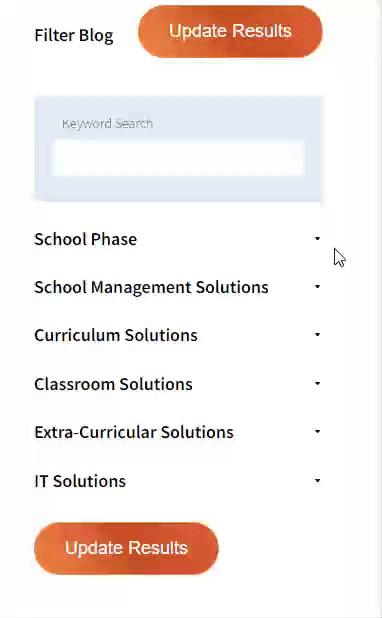


Our team sorts through all blog submissions to place them in the categories they fit the most - meaning it's never been simpler to gain advice and new knowledge for topics most important for you. This is why we have created this straight-forward guide to help you navigate our system.


And there you have it! Now your collection of blogs are catered to your chosen topics and are ready for you to explore. Plus, if you frequently return to the same categories you can bookmark your current URL and we will save your choices on return. Happy Reading!

The days are hot and long, it’s not quite late enough in the term to abandon lessons for extra rounders, despite popular public belief, you are not ‘winding down’.
Instead, the timetable is as busy as ever with transitions, sports days and productions. Less structure also means more planning for those whose needs don’t appreciate a change in routine.
Teachers’ minds move to next year. SLT desperately consider who works well (and doesn’t work well together), as well as attempting to distribute experience to ensure that at least someone might know what they are doing in September!
What can leaders do to support their teams at the end of term?
Having been on both sides of the fence, both waiting with trepidation for September plans to be announced and also part of the planning process, here are my 5 top tips.
1. Let people know where they will be working ASAP – I worked in one establishment where the LSA team still didn’t know on September 4th what class they would be in! Let staff know as soon as possible to alleviate any worries about change and allow them to plan for next year.
2. Classroom changes – where staff are changing rooms, make it a team effort and give them time to do it. The children also love to help, so allow staff to get them to help to carry things. Provide time to get going with displays. It’s not right for staff to give up their summer to sort out their classroom.
3. Transition conversations – ensure time is given to staff to find out about their new cohorts, read paperwork and liaise with previous teachers, especially for pupils with additional needs.
4. Planning time in new teams – help staff be prepared by allowing them to work in their new team and plan ahead sufficiently. Even if you give them twice as much time as usual, it won’t be enough!
5. Heat – make an effort to keep classrooms cool. No one can complain they are hot until they’ve attempted to teach 30 sweaty children in temperatures over 35°. Invest in fans and put in a plan for air con in the future as it’s getting hotter! No one can function at their best if they are overheating.
Finally, keep asking staff what would help them and remember your staff, just like the children, have individual needs as well to ensure that they can give their best.

The author

Read more

Read more

Read more

Read more

Read more

Read more

Read more

Read more


Are you looking for solutions? Let us help fund them! Nexus Education is a community of over 11,000 schools that come together to share best practise, ideas and CPD via online channels and free to attend events. Nexus also offers funding to all school groups in the UK via nexus-education.com


Established in 2011, One Education is a company at the heart of the education world, supporting over 600 schools and academies. Our unique appeal as a provider is in the breadth and synergy of the services we offer, supporting school leaders, teachers and support staff to achieve the best possible outcomes for their pupils and staff.

School Space is a social enterprise that has empowered schools for over 12 years through their profitable and hassle-free lettings services. So far, they’ve generated over £5 million in revenue for education, helping to connect over 200 schools with their local communities.


Unify is an online sales and marketing tool that allows users to create tailored personalised documents in moments.


There’s nothing special about the energy we sell. In fact, it’s exactly the same energy as all our competitors provide. But there is something special about the way we do it. Where others complicate the process, we simplify it. Where others confuse customers with hidden terms, we’re an open book. And where others do all they can to make as much money from their customers as possible, we do all we can to make as little. Everything we do, we do it differently. Our customers are a privilege. One we’ll never take advantage of.


Securus provide market-leading monitoring solutions to safeguard students on ALL devices both online and offline. We also offer a full monitoring service, where we carry out the monitoring on behalf of the school, freeing up valuable staff resources. From the smallest school to large MAT groups, Securus offers safeguarding protection for all!


Bodet Time offers dedicated solutions to education through lockdown alerts, class change systems, PA and synchronised clock systems. Improving time efficiency of the working and school day; ensuring safety through lockdown alerts; increasing communication with customised broadcast alerts.


Robotical makes Marty the Robot - a walking, dancing coding robot that makes programming fun and engaging for learners as young as 5. Our robots come with a full Learning Platform that has complete teaching resources, to make lesson planning a breeze.
One Reply to “5 Top Tips to Support Your Staff at the End of Term”